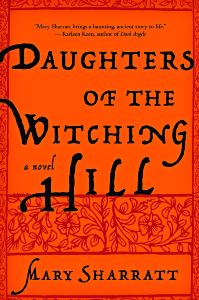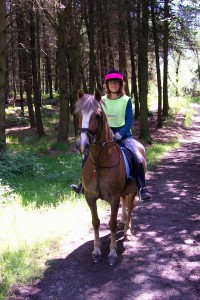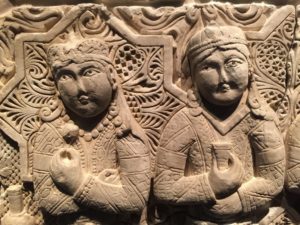
by Sandra Gulland | Nov 2, 2011 | Adventures of a Writing Life, On Plot, Recommended Books, Movies, Podcasts, etc., The Shadow Queen |
Ever since we returned to our winter home in San Miguel de Allende (Mexico), I’ve been working like crazy, getting ready for the sprint-revision of The Next Novel, which I’ve promised to send to my agent at the end of the month. (It was last due in May!)
I’ve recovered from the 4th draft conversion from 3rd person to 1st. That seems easy in comparison to the challenge now, which is figuring out an emerging important character and what happens to him. His story has evolved into a fairly important subplot (at draft 5!).
To help figure it out, I’ve laid out all the scenes on the big dining room table, puzzling over the flow of the story. (More than once, I groaned over the difficulty of writing a fact-based biographical novel.)
I’ve laid the cards out using the filmscript-writing structure proposed in Blake Snyder’s Save the Cat — a short, punchy and tad corny how-to book that offers quite a lot of helpful plot wisdom. (Scriptwriting and novel writing are two different beasts, but there can be fruitful cross-pollination. More on that later.)
But I shouldn’t be here, on-line — I should be figuring out The Story — but I got side-swiped this morning by the discovery that the opening line of The Next Novel made a shortlist of opening lines by agent Betsy Lerner in her irresistibly caustic blog: The Forest for the Trees.
The line?
Winter was coming — I could smell it.
Ironically, I changed that line yesterday to:
It was the season of turning, everything golden.
What do you think?
by Sandra Gulland | Feb 22, 2011 | Adventures of a Writing Life, Biographical Fiction, On Research |

I’ve known Mary Sharratt for some time on-line. I’ve read all of her novels, and have recommended them highly to friends and family. Daughters of the Witching Hill, her latest (now out in paperback), is her best yet: a wonderfully evocative novel of 17th century England.
Mary is a serious historical researcher, so I’m pleased to have the opportunity to interview her with respect to her research into the 17th century.
What do you find most challenging about research?
It’s not enough to just present the historical backdrop and pretty costumes. To me, the true challenge, and the mark of good historical fiction, is evoking the worldview and mentality of another age. In Daughters of the Witching Hill, I wanted to place the reader in a world where mainstream people—the wealthy and educated as well as the poor and illiterate—believed that magic was real. Where a fifty-year-old widow, walking past a stone quarry at twilight, could “come into her powers” by encountering a familiar spirit who took the form of a dazzling young man. Where one bad harvest or one disease epidemic could spell the difference on whether a family could survive the winter. The past is another country, another culture, with perceived realities very different to our own.
Tell us some of 17th century resources (on-line and print) you used most frequently.
For Daughters of the Witching Hill, the primary source material, A Wonderfull Discoverie of Witches in the Countie of Lancaster, the official transcripts of the 1612 Pendle Witch Trials, provided the backbone of the whole story. Not only was it a catalogue of each perceived act of witchcraft, but it also revealed local feuds and simmering resentments leading up to the trial, all presented in rich period language (daylight gate for twilight). Although it was strongly biased to flatter the prosecution, when read against the grain, the accused witch Elizabeth Southerns, aka Old Demdike, emerges as an unforgettably strong heroine:
She was a very old woman, about the age of Foure-score yeares, and had been a Witch for fiftie yeares. Shee dwelt in the Forrest of Pendle, a vast place, fitte for her profession: What shee committed in her time, no man knowes. . . . Shee was a generall agent for the Devill in all these partes: no man escaped her, or her Furies.
Outstanding new research on popular magic, social history, and Reformation Studies proved invaluable for putting this primary source material in context. Those who want an ?inside view? of historical magical practitioners will find many riches in Emma Wilby’s study, Cunning Folk and Familiar Spirits.
The King James Bible, completed in 1611, is a treasure trove of period language and imagery, as well as a stark mirror of its time, in which the scriptures are rewritten to further the King?s agenda. Exodus 22:18, originally translated as, “Thou must not suffer a poisoner to live,” became “Thou must not suffer a witch to live.” King James, author of Daemonologie, was convinced that a vast conspiracy of satanic witches was threatening to undermine his nation.
How do you organize your information? How do you keep track of it?
I write meticulous notes in a big notebook. I also keep a file of loose papers, maps, period illustrations, and computer print outs.
Is there software you find helpful?
Alas, no. I am the biggest Luddite you shall ever meet!
In your research into the 17th century, did you discover anything particularly surprising?
In Early Modern, post-Reformation Britain, Protestant authorities directly conflated recusant Catholicism with witchcraft. “No part of England hath so many witches,” Edward Fleetwood states in his 1645 pamphlet describing Lancashire, “none fuller of Papists.” Even Reginald Scot, one of the most enlightened men of the English Renaissance, thought the act of transubstantiation, the point in the Catholic mass where it is believed that the host becomes the body and blood of Christ, was an act of sorcery.
Mother Demdike’s family’s charms recorded in the trial transcripts mirror the ecclesiastical language of the pre-Reformation Church. Her incantation to cure a bewitched person, quoted by the prosecution as evidence of diabolical magic, is a moving and poetic depiction of the passion of Christ as witnessed by the Virgin Mary. This text is very similar to the White Pater Noster, an Elizabethan prayer charm Eamon Duffy discusses in his landmark book, The Stripping of the Altars: Traditional Religion in England: 1400-1580.
It appears that Mother Demdike, born in Henry VIII’s reign, at the cusp of the Reformation, was a practitioner of the kind of quasi-Catholic folk magic that would have been fairly common in earlier generations. Keith Thomas’s social history Religion and the Decline of Magic is an excellent study on how the Reformation literally took the magic out of Christianity.
What do you think are our most prevalent misconceptions about the 17th century?
Until very recently, the history of 17th century Britain has been presented as all too black and white, with dour Puritans battling effete and foppish cavaliers—it’s a tableau of caricatures. The lives of those caught between the clashes of Protestant and Catholic, Parliamentarian and Royalist, tend to get written out of history. As well as a time of sectarian violence, witchcraft hysteria, and civil war, this was a time of radical change that gave birth to many utopian grassroots movements, such as the Diggers and the Levellers. The Quaker religion, founded in 1652 after George Fox received his inspiring vision on top of Pendle Hill, is one of the most enduring legacies of these visionary times. The Quakers’ message of absolute human equality, including gender equality, and their rejection of war, feels as radically uncompromising today as it did nearly 400 years ago.
Thank you so much, Mary. That’s fascinating. (I’m putting your statement “The past is another country, another culture, with perceived realities very different to our own.” into my Quotes page.)

P.S. Mary and I share a love of horses. This is a photo of Mary exploring Pendle Hill on her sweet horse. What a perfect way to do research into the 17th century.
Be sure to visit Mary online: www.marysharratt.com.
by Sandra Gulland | Aug 6, 2010 | Adventures of a Writing Life |
.
.
The problem with writing fact-based fiction is … well … facts. They can really mess up a good story.
I’d read that the Mortemarts, the family of Athénaïs, Madame de Montespan, lived on rue de Rosiers.
Perfect: rue des Rosiers is not far from where Claude des Oeillets, my main character, lived when she first came to Paris. It worked into the story perfectly. Their lives do become entwined; nobody knows how their relationship began, but as a novelist it helped that they were walking distance from one another.
Twice I scouted rue de Rosiers on research trips to Paris. I took many photos, but more than that: I walked the cobbles, dreaming.
Unfortunately, I didn’t read the fine print at the back of one of the texts. Hôtel Mortemart was on another rue de Rosiers, a street that is now named rue Saint-Guillaume … far, far from my heroine Claude.
And that’s not entirely certain, either. Some accounts claim that Hôtel Mortemart on rue Saint-Guillaume was built in 1663?three years after the young women meet.
So where were the Mortemarts living in 1660?
I’ve spent all morning researching possibilities (when I should have been writing). Vivonne, the eldest child, was born in the Tuileries palace. Both high-ranking parents served the King and Queen for three months of the year, and were likely entitled to live there … so that’s a possibility, although they certainly would have had a residence of their own in Paris.
I’m not really sure what I’m going to do about this. I could leave the setting as it is and make a note about the change in the Author’s Note or on my website.
Or I could change it, place the Mortemarts either in the Tuileries or on rue Saint-Guillaume … difficult, and not necessarily good for the story.
I’m still perplexed.
by Sandra Gulland | May 4, 2010 | Adventures of a Writing Life |
Fact-based fiction? Biographical fiction? What does one call fiction that is based on the life of a historical character? I like Joyce Carol Oates’ expression: “biographically fueled fiction.”
Here’s what she had to say about it in a review of a biographical novel about Emily Dickinson in the New York Review of Books:
In these exemplary works of biographically fueled fiction it’s as if the postmodernist impulse to rewrite and revise the past has been balanced by a more Romantic wish to reenter, renew, and revitalize the past: not to suggest an ironic distance from its inhabitants but to honor them by granting them life again, including always the stumbling hesitations, misfires, and despair of actual life….
Just a snippet … I’m packing for France: research with wine and cheese.
SaveSave

by Sandra Gulland | Mar 12, 2008 | Baroque Explorations |
It disturbs me that “fiction” is getting such a bad rap in the U.S. press, that publishers feel they can’t market a novel, but that a true story is okay, that readers hunger for “truth” and will pay for it.
Since when has memoir been held to documentary standards? Memoir is a story created from life. I write historical fiction, and in delving into the research, I’ve come to see quite clearly that historians write fiction, as well. The line between fact and fiction is fuzzy, always, and I don’t understand this urge to nail it down. Facts can be misleading, and fiction can be revealing.
Story is how we explain the past — our history — to ourselves. Story is a powerful tool, and it is story that sets us apart from the world of animals (at least insofar as we know!).
Yet I’m guilty myself, I know. I love that “wow” moment when reading historical texts, thinking: Imagine: this actually happened. I think the issue is not whether something is true or false, but the understanding, the contract that is created between the author and reader. The outrage is: “We have been misled.” Frey’s memoir was more fiction than fact, but was marketed as fact. Even so, I have trouble understanding the furor.
One of my first historical reveries was brought on by a diary I read of a Quaker young woman in 18th century England. I was swept away by this “true” account. On my next trip to London, I researched her life; it was there that I learned that the diary was fiction, a novel. I felt disillusioned, let down, but then thought: “What a good novel.” For it drew me into the world of the past in a very real way – and that’s what fiction can do that fact cannot.
SaveSave
SaveSave
SaveSave






